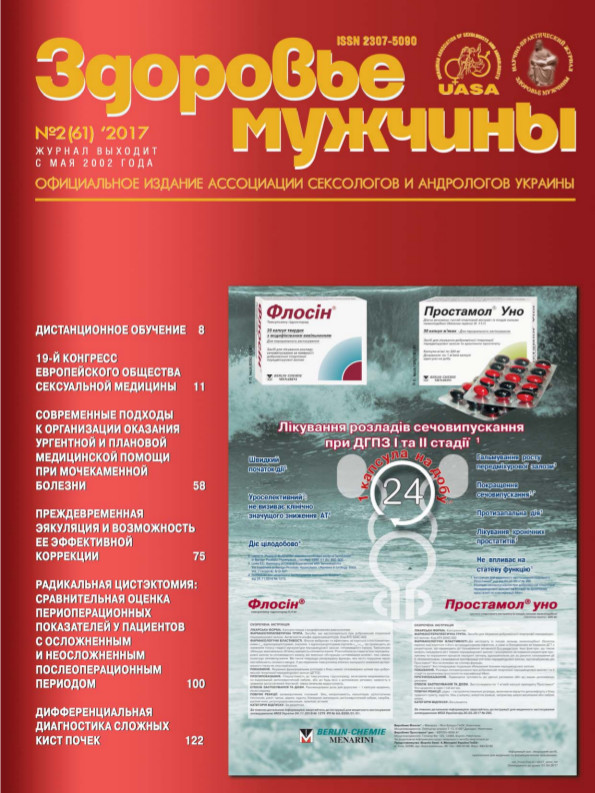Uzing of endourethral and intravaginal electrostimulation of urethral sphincter and pelvic floor muscles іn complex treatment of women with stress urinary incontinence without prolapse of pelvic organs
##plugins.themes.bootstrap3.article.main##
Abstract
The objective: determine the effectiveness of the use of endourethral and intravaginal electrostimulation (ES) of the sphincter apparatus of the urethra and pelvic floor muscles in the complex treatment of women with stress incontinence (SNM) with the Intraton-1 apparatus.
Patients and methods. The analysis of complex treatment of 163 women with stress urinary incontinence without prolapse of pelvic organs by uzing of endourethral (102 patients) and intravaginal (61patients) electrostimulation of urethral sphincter and pelvic floor muscles was carried out for the last 25 years.
Results. After endourethral electrostimulation recovery was noted in 37 (36,3%) women, improvement in 51 (50%) women, without changing in 14 (13,7%) women. After intravaginal electrostimulation recovery was noted in 24 (39,3%) women, improvement in 31 (50,8%) women, without changing in 6 (9,8%). Results of treatment in both groups were not statistically different but intravaginal electrostimulation was less invasive procedure and was not needed using of medicine drugs for prophуlacsis disuria and cystitis.
Conclusion. Because of recurrence symptoms of stress urinary incontinence in most of patients after 3–6 month after electrostimulation they are needed in repeated courses of electrostimulation after that period of time.
##plugins.themes.bootstrap3.article.details##

This work is licensed under a Creative Commons Attribution 4.0 International License.
Authors retain the copyright and grant the journal the first publication of original scientific articles under the Creative Commons Attribution 4.0 International License, which allows others to distribute work with acknowledgment of authorship and first publication in this journal.
References
Аполихина И.А., Константинов В.В., Деев А.Д. Распространенность и социальные аспекты недержания мочи у женщин // Акушерство и гинекология. – 2005. – No 5. – С. 32–36.
Горовий В.І., Головенко В.П., Кобзін О.Л. та ін. Ендоуретральна електростимуляція шийки сечового міхура в комплексному лікуванні стресового нетримання сечі у жінок // Медицинская реабилитаци, курортология, физиотерапия. – 2004. – No 4 (40). – С. 52–54.
Горовий В.І. Можливості консервативної терапії нетримання сечі у жінок без пролапса тазових органів // Медицинские аспекты здоровья женщины. – 2013. – No 3 (67). – С. 53–60.
Переверзев А.С. Клиническая урологинекология. – Харьков; Факт, 2000. – 360 c.
Салов П.П. Недержание у девочек и женщин, у мальчиков и мужчин, у пожилых людей. – Новосибирск, 2001. – 128 с.
Терадов А.Н. Недержание мочи при напряжении у женщин. – Кишинёв: Картя Молдовеняскэ, 1968. – 208 с.
Abrams P., Artibani W. Understanding stress urinary incontinence. – Lier, Belgium: Ismar Healthcare, 2004. – 96 p.
Koelbl H., Igawa Ty., Salvatore S. et al. Pathophysiology of urinary incontinence, faecal incontinence and pelvic organ prolapse // Incontinence / Abrams P. et al. – 5th ed. – Com.4. – ICUD – EAU, 2013. – P. 261–360.
Burkhurd F. C., Lucas M.G., Berghmans L.C. et al. Guidelines on urinary incontinence in adults // EAU Guidelines. – 2016. – 75 p.
Milson I., Altman D., Cartwright R. et al. Epidemiology of urinary incontinence (UI) and other lower urinary tract symptoms (LUTS), pelvic organ prolapse (POP) and anal incontinence (AI) // Incontinence / Abrams P. et al. – 5th ed. – Com.1. – ICUD-EAU, 2013. – P. 15–107.
Morre K., Dumoulin C., Bradly C. Adult conservative management // Incontinence / Abrams P. et al. – 5th ed. – Com.12. – ICUD – EAU, 2013. – P. 1101–1230.
Plevnik S., Vadusek D.B., Bryan N.P. et al. Electrical therapy // Clinical urogynaecology / Stanton S.L., Monga A.K. – second ed. – London – Toronto: Churchill Livingstone, 2000. – P. 521–540.
Sand P.K., Richardson D.A., Staskin D.R. et al. Pelvic floor electrical stimulation in the treatment of genuine stress incontinence: a multicenter, placebo-controlled trial // Am. J. Obstet. Gynecol. – 1995. – Vol. 173. – P. 72–79.
Yamanishi T., Yasuda K., Sakakibara R. et al. Pelvic floor electrical stimulation in the treatment of stress incontinence : on investigational study and a placebo controlled double-blind trial // J. Urol. – 1997. – Vol. 158. – P. 2127–2131.
Vodusek D.B., Laycock J. Therapeutic electrical stimulation // Haslam J., Laycock J. Therapeutic management of incontinence and pelvic pain. – 2-nd edition. – Springer-Verlag Londo Limited, 2008. – P. 121–126.





